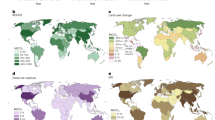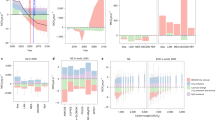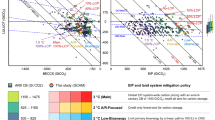Abstract
Rapid emissions reductions, including reductions in deforestation-based land emissions, are the dominant source of global climate mitigation potential in the coming decades. However, carbon dioxide removal (CDR) will also have an important role to play. Despite this, it remains unclear whether current national proposals for CDR align with temperature targets. Here we show the ‘CDR gap’, that is, CDR efforts proposed by countries fall short of those in integrated assessment model scenarios that limit warming to 1.5 °C. However, the most ambitious proposals for CDR are close to levels in a low-energy demand scenario with the most-limited CDR scaling and aggressive near-term emissions reductions. Further, we observe that many countries propose to expand land-based removals, but none yet commit to substantively scaling novel methods such as bioenergy carbon capture and storage, biochar or direct air carbon capture and storage.
This is a preview of subscription content, access via your institution
Access options
Access Nature and 54 other Nature Portfolio journals
Get Nature+, our best-value online-access subscription
$29.99 / 30 days
cancel any time
Subscribe to this journal
Receive 12 print issues and online access
$209.00 per year
only $17.42 per issue
Buy this article
- Purchase on Springer Link
- Instant access to full article PDF
Prices may be subject to local taxes which are calculated during checkout




Similar content being viewed by others
Data availability
The data for this Analysis are available via Zenodo at https://doi.org/10.5281/zenodo.10821849 (ref. 69). All raw and processed data are freely accessible, except for complete national-level CDR estimates in 2030 (that is, from the NDCs and other national documents) which will be made available upon reasonable request. Source data are provided with this paper.
Code availability
The code for this Analysis is available via Zenodo at https://doi.org/10.5281/zenodo.10821849 (ref. 69).
References
IPCC: Summary for Policymakers. In Climate Change 2022: Mitigation of Climate Change (eds Shukla, P. R. et al.) (Cambridge Univ. Press, 2022).
Smith, S. M. et al. The State of Carbon Dioxide Removal 1st edn (The State of Carbon Dioxide Removal, 2023); https://www.stateofcdr.org
Babiker, M. et al. in Climate Change 2022: Mitigation of Climate Change (eds Shukla, P. R. et al.) Ch. 12 (Cambridge Univ. Press, 2022).
Tracking Clean Energy Progress (IEA, 2022); https://www.iea.org/topics/tracking-clean-energy-progress
Climate Action Tracker (New Climate Institute and Climate Analytics, 2023); https://climateactiontracker.org/
Boehm, S. et al. State of Climate Action 2022 (WRI, 2022); https://doi.org/10.46830/wrirpt.22.00028
Emissions Gap Report 2022: The Closing Window — Climate Crisis Calls for Rapid Transformation of Societies (UNEP, 2022); https://www.unep.org/emissions-gap-report-2022
den Elzen, M. G. J. et al. Updated nationally determined contributions collectively raise ambition levels but need strengthening further to keep Paris goals within reach. Mitig. Adapt. Strateg. Glob. Change 27, 33 (2022).
Meinshausen, M. et al. Realization of Paris Agreement pledges may limit warming just below 2 °C. Nature 604, 304–309 (2022).
Rogelj, J. et al. Credibility gap in net-zero climate targets leaves world at high risk. Science 380, 1014–1016 (2023).
Rogelj, J., Geden, O., Cowie, A. & Reisinger, A. Net-zero emissions targets are vague: three ways to fix. Nature 591, 365–368 (2021).
Dooley, K. et al. The Land Gap Report 2022 (Climate Resource, 2022); https://www.landgap.org/
Smith, H. B., Vaughan, N. E. & Forster, J. Long-term national climate strategies bet on forests and soils to reach net-zero. Commun. Earth Environ. 3, 305 (2022).
Buck, H. J., Carton, W., Lund, J. F. & Markusson, N. Why residual emissions matter right now. Nat. Clim. Change 13, 351–358 (2023).
Lund, J. F., Markusson, N., Carton, W. & Buck, H. J. Net zero and the unexplored politics of residual emissions. Energy Res. Soc. Sci. 98, 103035 (2023).
McLaren, D. P., Tyfield, D. P., Willis, R., Szerszynski, B. & Markusson, N. O. Beyond ‘net-zero’: a case for separate targets for emissions reduction and negative emissions. Front. Clim. 1, 4 (2019).
Carton, W., Lund, J. F. & Dooley, K. Undoing equivalence: rethinking carbon accounting for just carbon removal. Front. Clim. 3, 664130 (2021).
Friedlingstein, P. et al. Global Carbon Budget 2023. Earth Syst. Sci. Data 15, 5301–5369 (2023).
Powis, C. M., Smith, S. M., Minx, J. C. & Gasser, T. Quantifying global carbon dioxide removal deployment. Environ. Res. Lett. https://doi.org/10.1088/1748-9326/acb450 (2023).
Byers, E. et al. AR6 scenarios database hosted by IIASA. Zenodo https://doi.org/10.5281/zenodo.5886911 (2022).
Gidden, M. J. et al. Aligning climate scenarios to emissions inventories shifts global benchmarks. Nature 624, 102–108 (2023).
Buylova, A., Fridahl, M., Nasiritousi, N. & Reischl, G. Cancel (out) emissions? The envisaged role of carbon dioxide removal technologies in long-term national climate strategies. Front. Clim. 3, 675499 (2021).
Grubler, A. et al. A low energy demand scenario for meeting the 1.5 °C target and sustainable development goals without negative emissions technologies. Nat. Energy 3, 515–527 (2018).
Soergel, B. et al. A sustainable development pathway for climate action within the UN 2030 Agenda. Nat. Clim. Change 11, 656–664 (2021).
Fuss, S. et al. Negative emissions—Part 2: costs, potentials and side effects. Environ. Res. Lett. 13, 063002 (2018).
Mo, L. et al. Integrated global assessment of the natural forest carbon potential. Nature 624, 92–101 (2023).
Fyson, C. L. & Jeffery, M. L. Ambiguity in the land use component of mitigation contributions toward the Paris Agreement goals. Earths Future 7, 873–891 (2019).
Benveniste, H., Boucher, O., Guivarch, C., Treut, H. L. & Criqui, P. Impacts of nationally determined contributions on 2030 global greenhouse gas emissions: uncertainty analysis and distribution of emissions. Environ. Res. Lett. 13, 014022 (2018).
Strefler, J. et al. Carbon dioxide removal technologies are not born equal. Environ. Res. Lett. 16, 074021 (2021).
Fuss, S. et al. Betting on negative emissions. Nat. Clim. Change https://doi.org/10.1038/nclimate2392 (2014).
Keyßer, L. T. & Lenzen, M. 1.5 °C degrowth scenarios suggest the need for new mitigation pathways. Nat. Commun. 12, 2676 (2021).
Geden, O. Climate advisers must maintain integrity. Nature 521, 27–28 (2015).
Bergman, A. & Rinberg, A. in CDR Primer (eds. Wilcox, J. et al.) Ch. 1 (Hemlock Printers, 2021).
Carton, W., Hougaard, I., Markusson, N. & Lund, J. F. Is carbon removal delaying emission reductions? WIREs Clim. Change https://doi.org/10.1002/wcc.826 (2023).
Moe, E. & Røttereng, J.-K. S. The post-carbon society: rethinking the international governance of negative emissions. Energy Res. Soc. Sci. 44, 199–208 (2018).
Lamb, W. F. et al. Discourses of climate delay. Glob. Sustain. 3, e17 (2020).
Painter, J. et al. Climate delay discourses present in global mainstream television coverage of the IPCC’s 2021 report. Commun. Earth Environ. 4, 118 (2023).
Grassi, G. et al. The key role of forests in meeting climate targets requires science for credible mitigation. Nat. Clim. Change 7, 220–226 (2017).
Grassi, G. et al. Carbon fluxes from land 2000–2020: bringing clarity to countries’ reporting. Earth Syst. Sci. Data 14, 4643–4666 (2022).
Giebink, C. L. et al. The policy and ecology of forest-based climate mitigation: challenges, needs, and opportunities. Plant Soil 479, 25–52 (2022).
IPCC: Summary for Policymakers. In Climate Change and Land: An IPCC Special Report on Climate Change, Desertification, Land Degradation, Sustainable Land Management, Food Security, and Greenhouse Gas Fluxes in Terrestrial Ecosystems (eds Shukla, P. R. et al.) (Cambridge University Press, 2019).
Kraxner, F. & Nordström, E.-M. in The Future Use of Nordic Forests (eds Westholm, E. et al.) 63–81 (Springer, 2015).
Hyyrynen, M., Ollikainen, M. & Seppälä, J. European forest sinks and climate targets: past trends, main drivers, and future forecasts. Eur. J. Forest Res. https://doi.org/10.1007/s10342-023-01587-4 (2023).
Korosuo, A. et al. The role of forests in the EU climate policy: are we on the right track? Carbon Balance Manage. 18, 15 (2023).
Nemet, G., Greene, J., Müller-Hansen, F. & Minx, J. C. Dataset on the adoption of historical technologies informs the scale-up of emerging carbon dioxide removal measures. Commun. Earth Environ. 4, 397 (2023).
Strefler, J. et al. Between Scylla and Charybdis: Delayed mitigation narrows the passage between large-scale CDR and high costs. Environ. Res. Lett. 13, 044015 (2018).
Prütz, R., Strefler, J., Rogelj, J. & Fuss, S. Understanding the carbon dioxide removal range in 1.5 °C compatible and high overshoot pathways. Environ. Res. Commun. 5, 041005 (2023).
Realmonte, G. et al. An inter-model assessment of the role of direct air capture in deep mitigation pathways. Nat. Commun. 10, 3277 (2019).
Fuhrman, J. et al. Diverse carbon dioxide removal approaches could reduce impacts on the energy–water–land system. Nat. Clim. Change https://doi.org/10.1038/s41558-023-01604-9 (2023).
Luderer, G. et al. Residual fossil CO2 emissions in 1.5–2 °C pathways. Nat. Clim. Change 8, 626–633 (2018).
Breyer, C. et al. Proposing a 1.0 °C climate target for a safer future. PLoS Clim. 2, e0000234 (2023).
Riahi, K. et al. Cost and attainability of meeting stringent climate targets without overshoot. Nat. Clim. Change 11, 1063–1069 (2021).
Emmerling, J. et al. The role of the discount rate for emission pathways and negative emissions. Environ. Res. Lett. 14, 104008 (2019).
van Vuuren, D. P. et al. Alternative pathways to the 1.5 °C target reduce the need for negative emission technologies. Nat. Clim. Change 8, 391–397 (2018).
Fasihi, M., Efimova, O. & Breyer, C. Techno-economic assessment of CO2 direct air capture plants. J. Clean. Prod. 224, 957–980 (2019).
Andreoni, P., Emmerling, J. & Tavoni, M. Inequality repercussions of financing negative emissions. Nat. Clim. Change 14, 48–54 (2024).
Fuhrman, J. et al. Food–energy–water implications of negative emissions technologies in a +1.5 °C future. Nat. Clim. Change 10, 920–927 (2020).
Crippa, M. et al. CO2 Emissions of All World Countries – 2022 Report (European Commission, 2022); https://edgar.jrc.ec.europa.eu/dataset_ghg70
Forster, P. et al. in Climate Change 2021: The Physical Science Basis (eds Masson-Delmotte, V. et al.) Ch. 7 (Cambridge Univ. Press, 2021).
Minx, J. C. et al. Negative emissions—Part 1: research landscape and synthesis. Environ. Res. Lett. 13, 063001 (2018).
Gasser, T. & Ciais, P. A theoretical framework for the net land-to-atmosphere CO2 flux and its implications in the definition of ‘emissions from land-use change’. Earth Syst. Dyn. 4, 171–186 (2013).
Grassi, G. et al. Critical adjustment of land mitigation pathways for assessing countries’ climate progress. Nat. Clim. Change 11, 14 (2021).
Grassi, G. et al. Harmonising the land-use flux estimates of global models and national inventories for 2000–2020. Earth Syst. Sci. Data 15, 1093–1114, 2023.
Gütschow, J. & Pflüger, M. The PRIMAP-hist national historical emissions time series (1750–2021) v2.4.2. Zenodo https://doi.org/10.5281/zenodo.7727475 (2023).
Mitigation Paths and Policy Instruments to Reach Brazilian Goals in the Paris Agreement (MCIT, 2017); https://www.gov.br/mcti/pt-br/acompanhe-o-mcti/sirene/publicacoes/acordo-de-paris-e-ndc/arquivos/pdf/trajetoriasebookb_final.pdf
Smith, H., Vaughan, N. E. & Forster, J. Navigating Net Zero: Analysing Residual Emissions in Long-Term National Climate Strategies. Preprint at https://doi.org/10.2139/ssrn.4678157 (2024).
In-Depth Analysis in Support on the COM(2018) 773 (European Commission, 2018); https://climate.ec.europa.eu/system/files/2019-08/long-term_analysis_in_depth_analysis_figures_20190722_en.pdf
Friedlingstein, P. et al. Global carbon budget 2021. Earth Syst. Sci. Data 14, 1917–2005 (2022).
Lamb, W. The carbon dioxide removal gap dataset (version 1) [Data set]. Zenodo https://doi.org/10.5281/zenodo.10821849 (2024).
Acknowledgements
This work was supported by the European Union ERC-2020-SyG ‘GENIE’ (951542) grant (W.F.L., J.C.M., G.N., T.G., M.J.G., Y.P., J.S., K.R.); the UK Natural Environment Research Council ‘CO2RE Hub’ (NE/V013106/1) grant (S.M.S.); the European Union Horizon 2020 ‘ESM2025’ (101003536) and ‘RESCUE’ (101056939) grants (T.G.); the German Federal Ministry of Education and Research ‘CDRSynTra’ (01LS2101A) (J.C.M., O.G.) and ‘ASMASYS’ (01LS2101A) grants (O.G.).
Author information
Authors and Affiliations
Contributions
W.F.L., G.N., S.M.S., O.G., K.R. and J.C.M conceived the idea for the paper. W.F.L., T.G., R.M.R.-C., G.G., M.J.G., C.M.P., Y.P., J.S., N.E.V. and H.S. contributed to data gathering and the analysis. W.F.L. wrote the paper. All authors contributed to drafting, reviewing and editing the paper.
Corresponding author
Ethics declarations
Competing interests
The authors declare no competing interests.
Peer review
Peer review information
Nature Climate Change thanks Andres Clarens, Wim Carton and the other, anonymous, reviewer(s) for their contribution to the peer review of this work.
Additional information
Publisher’s note Springer Nature remains neutral with regard to jurisdictional claims in published maps and institutional affiliations.
Supplementary information
Supplementary Information
Supplementary Discussion, Figs. 1 and 2, and Table 1.
Source data
Source Data Fig. 2
Statistical source data.
Source Data Fig. 3
Statistical source data.
Source Data Fig. 4
Statistical source data.
Rights and permissions
Springer Nature or its licensor (e.g. a society or other partner) holds exclusive rights to this article under a publishing agreement with the author(s) or other rightsholder(s); author self-archiving of the accepted manuscript version of this article is solely governed by the terms of such publishing agreement and applicable law.
About this article
Cite this article
Lamb, W.F., Gasser, T., Roman-Cuesta, R.M. et al. The carbon dioxide removal gap. Nat. Clim. Chang. (2024). https://doi.org/10.1038/s41558-024-01984-6
Received:
Accepted:
Published:
DOI: https://doi.org/10.1038/s41558-024-01984-6



